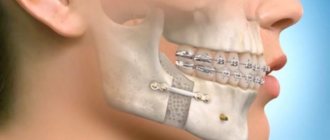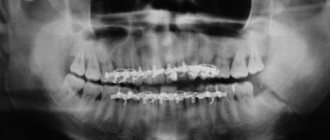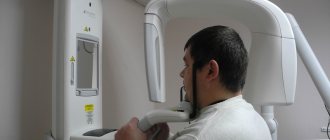Any injury to the bones of the skull is extremely dangerous. The jaw is most often affected; young men aged 18 to 40 are at risk. Fractures of the upper and lower jaw require serious and immediate treatment
, so it is very important to contact a specialist in time.
Main causes of jaw fracture
Such pathologies arise under the influence of mechanical stress on the bone, the force of which exceeds its strength. Most often, fractures of the maxillofacial region (MFA) occur in the following cases:
- Road traffic accidents.
- Extreme sports.
- Pronounced physical impact.
- Firearms.
Not everyone who finds themselves in such unpleasant situations suffers a broken jaw. The skull bones are very strong, so the incident must be really serious. True, there are people who are more susceptible to non-gunshot fractures of the lower and upper jaw than others.
If the following conditions are present, the bones of the skull break more often and more easily:
- Oncological diseases.
- Inflammatory processes in bone tissue.
- Infectious diseases, especially tuberculosis.
- Taking certain medications.
- Impaired bone mineralization.
- Metabolism problems.
- Acute deficiency of vitamins and microelements.
Diagnostics
The fracture is diagnosed by an oral and maxillofacial surgeon. An x-ray may show different degrees of damage:
- partial damage - damage to part of the bone, not complete detachment;
- non-displaced fracture – damage to all parts of the bone;
- complete fracture - the x-ray shows a gap between the separated part and the skull;
- fracture in different places - damage to the alveolar process in different places, bone fragmentation;
- fracture with deformation - a completely torn off part, displaced at a different angle.
Symptoms of a jaw fracture
A bone fracture is always painful, so it is impossible not to notice it. And yet, people sometimes confuse the signs of a jaw fracture and a dislocation and, not realizing the seriousness of the situation, try to solve the problem at home. To correctly identify an injury, you need to know its main symptoms:
- Pain that intensifies when touching the chin and any movement of the jaw.
- Unnatural bone mobility.
- Malocclusion. In many cases, a person cannot close his jaw at all.
- Photo: spaces between teeth due to a jaw fracture
Gaps almost always form in the dentition.
- In most cases, teeth break or fall out.
- Changes in the relief of bones, especially in the chin area. The injury noticeably displaces him.
- Hematomas and bruises appear on the face and in the oral cavity.
- Increased salivation.
- Recession of the tongue.
- In most cases, the patient is completely unable to speak, eat or move his jaw normally.
- General malaise occurs. The patient suffers from headache and dizziness. Sometimes the temperature rises and drowsiness appears.
All these symptoms can be considered general. They are typical for any type of similar injury, but there are also narrower signs on which the classification of fractures of the lower and upper jaw depends.
Rubber bands for splinting
In some cases, splinting with wire requires additional fastening with special rubber bands to fix the jaws in a closed state. The main purpose of the rubber bands is to move the teeth in the direction in which they were originally. There are many advantages of elastic material:
- The rubber bands are easy to cut and remove, which is especially important if the patient has suffered a head injury and there is a risk of complications in the form of epileptic seizures, fainting and other neurological disorders.
- With the correct tension, the elastic bands allow you to take food through a tube; a tighter fastening often leads to tube feeding.
- Damaged rubber bands can be easily replaced, while damage to the metal structure will require serious medical intervention.
The decision to install rubber bands for splinting must be made by a doctor and most often they begin to be used only when primary healing of the injured jaw has occurred. In the first stages, as a rule, more rigid fixation is required. In any case, consultation with a specialist is required, who, based on the condition of the teeth, the nature of the damage, and the general condition of the patient, will be able to determine the most suitable type of splinting. Dr. Sadov’s clinic in Moscow employs professionals who have completed internships abroad and clearly understand the specifics of dental orthopedics.
Classification of jaw fractures
Experts distinguish more than a dozen different types of fractures, and the treatment of the patient depends entirely on whether the injury belongs to one type or another. First of all, fractures of the lower and upper jaw can be distinguished, but these groups are also divided into several smaller ones depending on a number of signs.
Types of jaw fractures by severity of injury
- Closed fracture. It damages the bone, but the surrounding soft tissue remains intact. This type of pathology is less dangerous, since the treatment lasts relatively short. A non-gunshot closed fracture of the lower jaw heals without complications in 3–4 weeks.
- Open fracture. Bone fragments can move to the side and damage soft tissues, blood vessels and joints. This pathology can be recognized by severe bleeding. Open fractures of the lower jaw are more common.
An open injury is doubly dangerous, since it carries a high risk of bacterial infection and severe blood loss. Medical assistance must be provided immediately.
Types of jaw fractures based on displacement of fragments
- Fracture without displacement. With such an injury, the bone can even be divided into multiple fragments, but they are in a standard position and do not move relative to each other. The crack may be incomplete. Injury is easier to treat and carries with it minimal consequences.
- Displaced fracture. In this case, the jaw fragments change their position, which causes additional pain and complicates treatment. With open injuries, the bone is always displaced.
A displaced fracture of the lower jaw is more common than the same injury to the upper part of the skull. Damage can be recognized by severe swelling and facial asymmetry. - Comminuted fracture. The bone splits into separate fragments of different sizes, which are arranged in a chaotic manner. In most cases, the pathology is accompanied by damage to soft tissues and requires immediate medical attention and long-term treatment. Often, after hospitalization, patients also have to see a plastic surgeon.
Types of jaw fractures by location of injury
The types of fractures of the lower and upper jaw are determined not only by symptoms, but also by location:
- A midline fracture is located in the middle of the bone.
- If the injury is located near the lateral incisors, it is defined as incisive.
- A canine fracture is an injury to the third teeth of the upper or lower jaw.
- A crack in the chin area is designated as mental. It is one of the most common jaw injuries due to the fact that a person's chin protrudes noticeably.
- An angular fracture can only occur in the lower jaw. It is located in the corners of this bone, closer to the base of the skull.
Doctors may use a more extensive classification of such injuries. It’s even difficult to imagine exactly how many types of pathology there are - each case is individual in its own way.
Are fractures the same for everyone or are they always different?
Jaw fractures can be completely different, and it is impossible to independently determine which one you have. It all depends on the nature of the injury, the direction of the force, and the position of the person at the time of exposure to the traumatic factor. The diagnosis can only be made based on x-rays. Here are the main types and classifications of fractures:
- direct and indirect: in the first case, the area that was affected is directly injured. With an indirect injury, it is not the area of impact that is damaged, but the tissues located next to it,
- oblique, transverse, longitudinal: it all depends on the direction in which the fracture of the jaw bone will go,
- single and multiple: there can be only one fault, but most often there are many of them,
- large and small: if the bone is split into several fragments, then we are talking about a major fracture. If there are a lot of fragments and they are small, then doctors diagnose a minor fracture,
- one-sided and two-sided,
- open and closed: the first type involves damage not only to bone tissue, but to the mucous membrane, periodontal tissue, and teeth. The second type is much less common and only damages bone tissue.
Fractures can be different
First aid for a broken jaw
The very first thing to do if a person breaks their jaw is to call an ambulance. After this, measures can be taken to alleviate the victim’s condition:
- Since damage most often occurs in the event of an accident, fights, or falls, first of all you need to make sure that the person’s life is not in danger.
- If there are several non-gunshot injuries, the jaw should be addressed first. The exception is open fractures of other bones if the head injury is closed.
- If there is bleeding, apply a clean, preferably sterile, cloth to the wound. If the damage is minor, cotton wool will do.
- If the patient is unconscious, carefully turn him on his side. Clear your mouth of blood clots and vomit. This must be done extremely carefully, wrapping your finger in a clean cloth.
- Then you should put the patient in a comfortable position and try not to move him anymore. If the patient is conscious, a sling-shaped bandage is applied to the broken jaw, as in the photo on the right.
- Ice is applied to reduce pain. If possible, it is worth giving the victim painkillers. In this case, an intramuscular injection will be most effective. Analgin, Naproxen, Revalgin are suitable tablets.
Since the patient is unable to swallow, the painkiller tablet must be crushed and dissolved in water. If the person is unconscious, you can pump the liquid into a syringe without a needle and gently pour the medicine directly down the throat.
Comments
After installing the splint, is the patient allowed to go home or does he have to stay in the hospital?
Mike (06/26/2020 at 02:41 pm) Reply to comment
- It all depends on the nature of the injury, accompanying symptoms and the condition of the victim. If a person is unconscious, has fractures and injuries to other parts of the body, then he needs observation and specialized care, which can only be provided in a hospital.
Editorial staff of the portal UltraSmile.ru (06/29/2020 at 09:14) Reply to comment
A very unpleasant phenomenon. I wonder what to do with food for forty days. That is, the patient is unable to chew or take solid food at all. Will this have a negative impact on the digestive system if food comes in liquid form for several months?
Sergey Petrovich (07/23/2020 at 08:50) Reply to comment
How long do the consequences of a fracture of the lower jaw last? What I mean is that at the site of any fracture a certain callus appears. And how long does it usually take to make itself felt after an injury?
Vladimir Logvinov (07/23/2020 at 09:06) Reply to comment
Is it true that after a jaw fracture, this place becomes so vulnerable that if you put a little pressure on it, say, cracking a nut, and a second fracture will immediately occur?
Nikolay (07/23/2020 at 09:22) Reply to comment
Surely, after all, there are consequences from a fracture of the lower jaw, even if surgery and rehabilitation are performed, or only in difficult cases do there remain any consequences?
Lera (07/23/2020 at 09:30) Reply to comment
My husband broke his lower jaw when he hit himself at work. Now he is in the hospital, and through a bunch of bandages on his face, it seems to me that he did not have a very successful operation. What are the consequences if the operation is not performed correctly? Can this be fixed immediately before it is too late?
Zhanna (07/23/2020 at 10:24 am) Reply to comment
During a fight, along with a broken jaw, teeth are often damaged. Are there any contraindications to installing metal-ceramic implants after a jaw fracture has been healed?
Evgeniy (07/23/2020 at 14:37) Reply to comment
It’s very interesting whether this has ever happened in medical practice, when there are no obvious symptoms of a jaw fracture, but there is still a fracture? And is it possible to fully recover after a fracture, without any consequences?
Svetlana (07.23.2020 at 14:46) Reply to comment
Good afternoon My brother has had more than 21 days of rehabilitation, but his jaw is not healing well, the doctor reassures him that everything will heal, but we are worried. Tell me, should I worry or should I expect a full recovery?
Victor (07/23/2020 at 15:26) Reply to comment
Write your comment Cancel reply
Treatment of a jaw fracture
Splinting
Once the patient is admitted to the hospital, he is sent for an x-ray to find out if the jaw is broken and to determine the exact location and severity of the injury. The stages of treatment depend on the classification of the fracture. In most cases, splinting will be done, but additional therapies may be prescribed.
A special plastic device or wire structure is placed on the jaw on the damaged side. In case of injury on both sides of the bone, a more complex and rigid product is used. After installing the structure, a series of loops are formed in the smile area. The hooks on the upper and lower jaws are connected by elastic bands.
The main task of splinting is to maintain the immobility of bone tissue for exactly as long as the jaw fracture heals. Treatment usually lasts from 3 weeks to six months.
For displaced angular injuries, a bone suture is required.
To do this, the crack is exposed from soft tissue, and small holes are made in the bone fragments along the entire length of the fracture. Then the parts are connected to each other with a special wire and covered with soft cloth.
After the main operation, rehabilitation begins. For faster tissue regeneration, magnetic therapy, ultraviolet irradiation, calcium electrophoresis at the fracture site, or other therapeutic procedures are used.
Treatment of a jaw fracture at home
After 3–4 weeks, if the fracture is uncomplicated and the person is no longer in danger, he can be discharged from the hospital.
Usually by this time the bone has not completely healed, so the specialist gives a number of recommendations for continuing treatment at home:
- For an open fracture of the jaw, antibiotics are prescribed; after discharge from the hospital, you need to continue taking them at home.
- To speed up healing, multivitamin complexes rich in calcium and substances that improve its absorption are prescribed.
- You can treat a crack in the jaw with folk remedies, but before using them you need to consult a doctor. Most of all, experts approve of paraffin therapy.
- After removing the splint, you will have to wear a special fixing bandage for several months - first it is worn all day, and then only at night.
- If the splint has already been removed, the jaw needs to be developed. Every day for a few minutes a person should do simple exercises: move his jaw from side to side, open and close his mouth wide.
All of the recommendations listed can only be used as a supplement to the main treatment that takes place in the hospital. It is impossible to cure a fracture without medical help.
Nutrition for a jaw fracture
Due to the injury, the process of eating becomes more difficult, because it hurts the patient to even open his mouth, not to mention chewing. And yet a person must receive a sufficient amount of nutrients. This determines how long it will take for a crack in the jaw to heal. If there is a deficiency of nutrients, the treatment period increases and more complications appear, so the patient is fed according to certain rules:
- A rubber tube is inserted directly into the patient's throat, through which a nutrient solution or liquid food will be administered. Usually the tube is placed through an area where one or more teeth are missing, which happens quite often when the skull bones are damaged. If there is no gap, then the tube is placed in the mouth through the gap after the wisdom tooth. Such nutrition is convenient because it is possible even at home.
- If a patient with a jaw fracture is in intensive care, doctors make droppers with a special solution rich in nutrients, vitamins and minerals. If this is not possible, a nutritional enema is used.
- The basis of the diet is ground meat mixed with milk or broth, baby food, pureed soups, fruit and vegetable dishes, and liquid porridges.
- The patient will need more calories than he normally needs. In addition, the vitamin and mineral value of the diet increases.
How will the treatment be carried out?
How is pathology treated and what do doctors do for it? First, specialists restore vital body functions: breathing, heartbeat. Immediately after the patient is admitted to maxillofacial surgery, it is necessary to stop the bleeding and relieve acute pain. Then a thorough diagnosis of the condition is carried out using x-rays and the type and nature of the injury is determined, because this will determine how to treat a fracture of the lower jaw.
There are different methods of repositioning (comparing) and immobilizing (fixing) fragments. There are conservative (splinting) and operative (direct and indirect osteosynthesis). All of them allow you to assemble a broken jaw into a single whole.
Conservative treatment uses splinting
If, according to indications, the patient requires surgical intervention, then doctors act in the following sequence: antiseptic treatment is carried out, fragments are removed and the fractures are combined with each other. Various devices help to fasten fragments of bone tissue - intraosseous pins and screws, compression devices, and metal plates on the bone. Then the mucous membranes are sutured and sutured. Another mandatory step is the removal of teeth located in the damaged area. After the operation, doctors install a fixation splint.
The conservative method involves installing a therapeutic splint. As a rule, this is an intraoral intermaxillary structure that is attached to the teeth using a ligature wire.
Consequences of a jaw fracture
Such a complex injury cannot go away without a trace; even with proper treatment, certain complications are present:
- Deformation of facial features. Asymmetry arises, sometimes very noticeable (see photo). Typically, this consequence occurs when the jaw is fractured with displacement. With less dangerous pathologies, such a change is almost imperceptible.
- Loss of teeth and their curvature. In many cases, gaps form between the teeth and the bite is disrupted.
- The remaining teeth may become loose when chewing, most often this phenomenon occurs after an angular fracture.
- The vast majority of patients experience jaw crunching after treatment for a fracture. Moreover, this can last until the end of life.
- Due to liquid nutrition, problems with the gastrointestinal tract arise.
You need to understand that a head injury is always dangerous. Only correct and timely medical care will reduce the number of consequences to a minimum.
Can fragments heal incorrectly?
In 85% of clinical cases the outcome is favorable, that is, recovery occurs. But sometimes (in 7% of cases) a broken jaw does not heal as it should. Doctors attribute this to the fact that the patient did not follow all the recommendations and violated the regime. This may also be due to incorrectly chosen tactics and treatment methods, or poor fixation of fragments. But improper bone fusion is not the most dangerous consequence or complication of injury. Sometimes the patient’s suffering continues further because he develops traumatic osteomyelitis.
If not treated promptly or correctly, the fracture may heal incorrectly.
Osteomyelitis is a serious purulent-infectious lesion of the jaw bone tissue. It can occur due to a violation of asepsis at the time of the operation or after it, in the presence of unremoved and broken teeth, roots, caries, pulpitis, and periodontitis in the mouth.
A disease such as osteomyelitis, as well as untimely seeking of specialized help, can lead to the formation of a pseudarthrosis after the jaw has healed. This cosmetic defect greatly spoils the aesthetics of the face and disrupts the bite, so it needs to be corrected through surgical manipulation. But pathology can be completely avoided if the patient receives all the necessary medical care quickly and in a timely manner.
Notice
: Undefined variable: post_id in
/home/c/ch75405/public_html/wp-content/themes/UltraSmile/single-item.php
on line
45 Notice
: Undefined variable: full in
/home/c/ch75405/public_html/wp-content /themes/UltraSmile/single-item.php
on line
46
Rate this article:
( 2 ratings, average: 5.00 out of 5)
prevention
- Zoirov T.E., Bobamuratova D.T., Elnazarov A.T. The state of hygiene and periodontal disease during treatment using splinting in patients with a jaw fracture // Questions of science and education. – 2022.
Expert “After removing the splints, it is very important to sanitize the oral cavity and remove plaque, as well as restore the functionality and beauty of teeth damaged as a result of injury. Contact a dentist who will perform professional oral hygiene and, depending on the clinical situation, offer composite building, installation of crowns and veneers, prosthetics with removable and fixed structures, and implantation.” Dentist therapist, periodontist Marina Igorevna Tarabanovskaya
Consulting specialist
Tarabanovskaya Marina Igorevna
Specialization: Dentist therapist, periodontist Experience: 10 years









